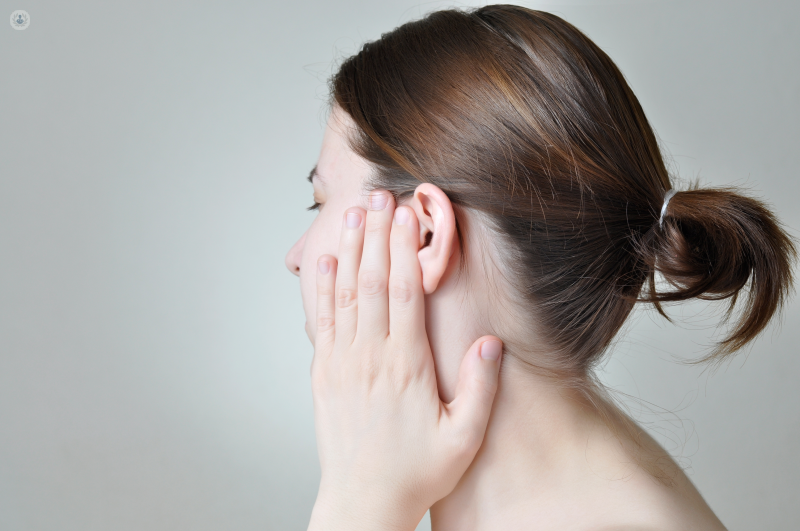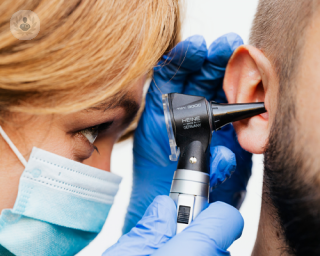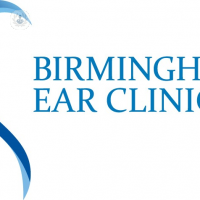What is glue ear?
Glue ear is where the empty middle part of the ear canal fills up with fluid (usually mucus). This can cause temporary hearing loss. Usually, the condition clears up within three months, but it’s advisable to see a doctor about any hearing problems. Glue ear can affect both ears at the same time.

Glue ear symptoms can include:
Glue ear is much more common in children, but adults usually have the same symptoms.
Your child may be struggling to hear if they often:
- Are difficult to understand
- Are speaking more quietly or loudly than usual
- Ask people to repeat what they say
- Turn up the volume on electronic devices or asks for it to be turned up
- Become distracted when people are talking
- Seem irritable or tired because it’s harder to listen
One of our specialists can usually diagnose glue ear by looking for inside fluid inside the ear. They'll often use a small scope with a magnifying glass and a light. This should not be painful.
If your child has had glue ear for more than three months, they may be referred to a specialist for hearing tests.
Treatment for glue ear
Glue ear is not always treated, and will usually get better on its own. It often clears up on its own within three months.
Your child may still be monitored for up to a year in case the symptoms change or get worse.
You may be advised to try nasal balloon auto inflation while waiting for symptoms to improve. Auto inflation can help fluid in the ear to drain.
It is done by either of these methods
- Holding the nostrils closed whilst swallowing
- Blowing up a special balloon using one nostril at a time
If glue ear causes an ear infection, you may need antibiotics.
Does my child need hospital treatment for glue ear?
Your child may be referred to a specialist in a hospital if:
- Glue ear symptoms are affecting the child’s development and learning.
- They already had severe hearing loss before glue ear.
- They have been diagnosed with a cleft lip and palate, or with Down's syndrome. If they have these conditions, it can mean glue ear is less likely to get better by itself.
The two main treatments are temporary grommets or hearing aids.
On rare occasions, surgery may be recommended to remove some glands called adenoids which are located at the back of the nose, above the roof of the mouth. This procedure is known as an adenoidectomy.
The specialist in the hospital will help you decide on the best treatment option.
Grommets for treating glue ear
Grommets are small temporary tubes that are placed in your child’s ear during surgery. They keep the eardrum open and help drain fluid away.
The grommet eventually falls out within six to 12 months as your child’s ear gets better.
Book an appointment with one of our specialists if you or your child are having hearing problems. It may be glue ear or another condition.
04-28-2017 05-03-2023Glue ear
Mr Kiran Varad - Otolaryngology / ENT
Created on: 04-28-2017
Updated on: 05-03-2023
Edited by: Carlota Pano
What is glue ear?
Glue ear is where the empty middle part of the ear canal fills up with fluid (usually mucus). This can cause temporary hearing loss. Usually, the condition clears up within three months, but it’s advisable to see a doctor about any hearing problems. Glue ear can affect both ears at the same time.

Glue ear symptoms can include:
Glue ear is much more common in children, but adults usually have the same symptoms.
Your child may be struggling to hear if they often:
- Are difficult to understand
- Are speaking more quietly or loudly than usual
- Ask people to repeat what they say
- Turn up the volume on electronic devices or asks for it to be turned up
- Become distracted when people are talking
- Seem irritable or tired because it’s harder to listen
One of our specialists can usually diagnose glue ear by looking for inside fluid inside the ear. They'll often use a small scope with a magnifying glass and a light. This should not be painful.
If your child has had glue ear for more than three months, they may be referred to a specialist for hearing tests.
Treatment for glue ear
Glue ear is not always treated, and will usually get better on its own. It often clears up on its own within three months.
Your child may still be monitored for up to a year in case the symptoms change or get worse.
You may be advised to try nasal balloon auto inflation while waiting for symptoms to improve. Auto inflation can help fluid in the ear to drain.
It is done by either of these methods
- Holding the nostrils closed whilst swallowing
- Blowing up a special balloon using one nostril at a time
If glue ear causes an ear infection, you may need antibiotics.
Does my child need hospital treatment for glue ear?
Your child may be referred to a specialist in a hospital if:
- Glue ear symptoms are affecting the child’s development and learning.
- They already had severe hearing loss before glue ear.
- They have been diagnosed with a cleft lip and palate, or with Down's syndrome. If they have these conditions, it can mean glue ear is less likely to get better by itself.
The two main treatments are temporary grommets or hearing aids.
On rare occasions, surgery may be recommended to remove some glands called adenoids which are located at the back of the nose, above the roof of the mouth. This procedure is known as an adenoidectomy.
The specialist in the hospital will help you decide on the best treatment option.
Grommets for treating glue ear
Grommets are small temporary tubes that are placed in your child’s ear during surgery. They keep the eardrum open and help drain fluid away.
The grommet eventually falls out within six to 12 months as your child’s ear gets better.
Book an appointment with one of our specialists if you or your child are having hearing problems. It may be glue ear or another condition.


Grommet surgery in adults: What to expect
By Miss Laura Harrison
2024-11-21
Grommet surgery, also known as tympanostomy or ventilation tube insertion, is a common procedure that's aimed to treat glue ear in adults. If you’re an adult with glue ear and you're considering grommet surgery, you may have questions about the procedure and what to expect. Leading adult and paediatric consultant ENT surgeon Miss Laura Harrison answers the main questions you might have before undergoing grommet surgery in this informative article. See more


Does my child have glue ear?
By Mr Kiran Varad
2024-11-19
Glue ear is a very common condition among children that occurs when fluid builds up in the middle ear. Here, Mr Kiran Varad, highly skilled consultant paediatric and general ENT surgeon, provides a detailed insight into glue ear in children, including causes, symptoms and treatment. See more


What can I do to help my child with glue ear?
By Mr Michael Kuo
2024-11-19
Have you noticed a high temperature and ear charge in your little one? It may be symptoms of glue ear! Top paediatric ENT surgeon Mr Michael Kuo explains the options available when it comes to treating a case of glue ear that isn’t clearing up by itself in children. See more


How do I know if my child has glue ear?
By Mr Michael Kuo
2024-11-17
Do you know how to spot the signs of glue ear in your little one? One of our top ENT surgeons Mr Michael Kuo explains the symptoms to watch out for and how long the middle ear infection should take to clear up. See more
Experts in Glue ear
-
Mr Richard Irving
Otolaryngology / ENTExpert in:
- Facial paralysis
- Vertigo
- Glue ear
- Deafness
- Acoustic neuroma
-
Mr Prince Modayil
Otolaryngology / ENTExpert in:
- Paediatric ENT
- Sinusitis
- Tonsillitis
- Adenoids
- Glue ear
- Sleep apnoea
-
Mr Sam Khemani
Otolaryngology / ENTExpert in:
- Sinusitis
- Tonsillitis
- Paediatric ENT
- Glue ear
- Nasal polyps
- Hearing loss
-
Mr Harry Powell
Otolaryngology / ENTExpert in:
- Cholesteatoma
- Cochlear Implants
- Otosclerosis
- Hearing loss
- Ear infection
- Glue ear
-
Mr Neil Fergie
Otolaryngology / ENTExpert in:
- Otology
- Dizziness
- Paediatric ENT
- Hearing loss
- Ear infection
- Glue ear
- See all

The Alexandra Hospital - part of Circle Health Group
The Alexandra Hospital - part of Circle Health Group
Mill Ln, Cheadle
No existe teléfono en el centro.
By using the telephone number provided by TOP DOCTORS, you automatically agree to let us use your phone number for statistical and commercial purposes. For further information, read our Privacy Policy
Top Doctors

The Priory Hospital - part of Circle Health Group
The Priory Hospital - part of Circle Health Group
Priory Road, Edgbaston, Birmingham B5 7UG
No existe teléfono en el centro.
By using the telephone number provided by TOP DOCTORS, you automatically agree to let us use your phone number for statistical and commercial purposes. For further information, read our Privacy Policy
Top Doctors

Birmingham Ear Clinic
Birmingham Ear Clinic
The Priory Hospital, Priory Road, B5 7UG
No existe teléfono en el centro.
By using the telephone number provided by TOP DOCTORS, you automatically agree to let us use your phone number for statistical and commercial purposes. For further information, read our Privacy Policy
Top Doctors
-
The Alexandra Hospital - part of Circle Health Group
Mill Ln, Cheadle, CheadleExpert in:
- Hip
- Cardiology
- Shoulder and elbow
- Paediatrics
- Foot and ankle
- Knee
-
The Priory Hospital - part of Circle Health Group
Priory Road, Edgbaston, Birmingham B5 7UG, EdgbastonExpert in:
- Cancer
- General Surgery
- Orthopaedic surgery
- Thoracic Surgery
- Obstetrics and Gynaecology
- Urology
-
Birmingham Ear Clinic
The Priory Hospital, Priory Road, B5 7UG, EdgbastonExpert in:
- Hearing Implants
- Otology
- Most viewed diseases, medical tests, and treatments
- Migraine
- Minimal access surgery (keyhole surgery)
- Head and neck cancer
- Neck lump
- Botulinum toxin (Botox™)
- Thyroid disorders
- Anti-ageing treatments
- Medicolegal
- Ear wax plugs
- Vertigo








